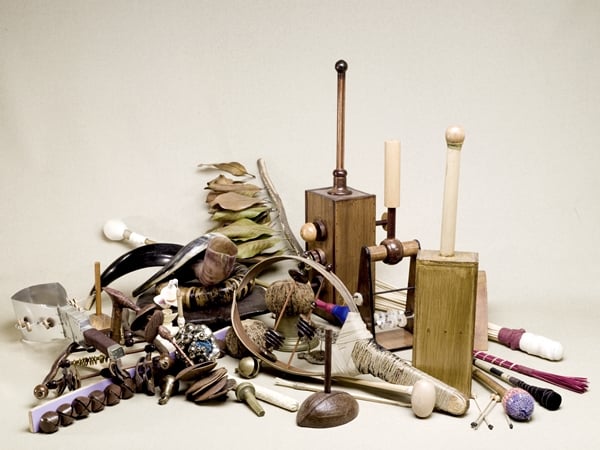
Courtesy the artist and Massimo De Carlo, Milan/London.
Installation view of Roberto Cuoghi, Šuillakku — corral version (2014) at the New Museum
Photo: Benoit Pailley
The New Museum has a handsome bunch of shows up right now, all of which deployed in one big shotgun burst, during the art fairs. Icelandic It boy Ragnar Kjartansson is the surefire crowd-pleaser, doing his neo-bohemian thing and staging a live jam band of dreamy music for several weeks; British artist Hannah Sawtell has a disorienting series of sculpture-picture-objects down in the lobby display space. But it’s the outwardly simplest, Roberto Cuoghi’s third-floor walk-in haunted house for ancient history buffs, “Šuillakku–corral version,” that distilled something for me about contemporary art, which seems awash in research-driven, nerdy works.
You walk through a dark curtain. A guard tells you to follow the lights down a corridor, and there you find yourself in a small 16-sided chamber, with fabric-lined walls. In the near-total-darkness, sound wails at you from every direction, at a volume just a little above comfortable—rhythmic chanting, maracas… is that a zither? The complete “Šuillakku–corral version” experience lasts about eight minutes. What is this, you ask? What is all the clanging and panting about?
Looping back out of the space, you can read the lengthy text that explains who Cuoghi is and what he is up to: He is an Italian artist (b. 1973), known for projects that require a high degree of personal commitment. The story is frequently told, and repeated here, of the 1998 performance project where he actually, through a combination of poor diet and frumpy clothing, transformed himself into his own father, prematurely aging himself in the name of art. For “Šuillakku–corral version,” he immersed himself for two years in the study of ancient Assyrian language and customs, then set out to build the instruments to recreate a chant of lamentation as it might have been heard in 612 BCE, during the declining era of the Empire. (He first launched this project in 2008; the current version is a new arrangement for the New Museum).
Documentary photography depicting the instruments made in preparation for Suillakku (2008).
Courtesy the artist and Massimo De Carlo, Milan/London.
Knowing this, you might head back in and listen to the whole thing over. Is the experience enriched? Maybe. You are now more sensitive to the notes of despair and anger amid all that freaky noise. But ultimately, the answer is, “not really,” not even if you stay so long in the little chamber that your eyes become sensitive enough that the lights of the power-strips behind the walls begin to glow through. “Šuillakku–corral version” is an exercise in ethnomusicology as entertainment, but you are literally in the dark about the lived experience behind it, or what it might mean in the present.
Why is Cuoghi interested in the Assyrian Empire? Perhaps he has some thought about the parallels of the fall of Assyria to our own present, which certainly feels like a time of decline. But it actually seems fairly important to me that we don’t know. Because the gravity of the tragedy seems remote here, the accent falls not on the meaning, but on the form of the project as a kind of elaborate ritual for nothing. Ancient Assyrian culture is important for its obscurity as a reference, not for its burning relevance, and Cuoghi’s pop-up chamber of sorrows is less about the reality of an ancient culture than about the reality that present-day artists are compelled to present themselves as if their work issued from a culture already dead: via invented rituals that are alien to all but the most erudite of viewers, and elaborate texts that reconstruct what they might have meant…
Thought of this way, “Šuillakku–corral version” is paradoxically actually amusing in a fairly intuitive way. It’s a form of conceptual performance that makes sense for our particular present conceptual environment, where armies of the anonymous spend vast amounts of time cultivating Wikipedia pages about the obscurest of topics, rendering the world’s mysteries into easily consumable form.
Roberto Cuoghi, “Šuillakku–corral version,” is on view at the New Museum through June 29, 2014